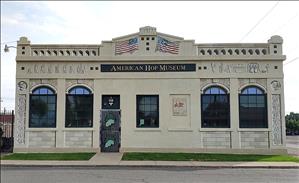On July 2, 1994, the American Hop Museum opens in Toppenish. The building, originally a creamery, dates to 1917, by which time hop growing had become big business in the Yakima Valley. Today Washington accounts for about 75 percent of the nation's annual production of hops, an essential ingredient in beer. The Museum includes historic photos, farming equipment, and production tools from years gone by, and also features an an outdoor space with early examples of hop machinery.
A Home in Toppenish
Toppenish, where the American Hop Museum opened in 1994, is among the Yakima Valley towns that boast a rich hop-growing heritage, along with nearby Mabton, Zillah, Moxee and others. The building that houses the museum dates back to 1917, originally the Trimble Brothers Creamery. In more recent years it was the Hop Growers Supply Building.
Hops, the pale green, aromatic cones of bines that flourish throughout the Yakima Valley, played an early role in agricultural development on both sides of the Cascade Mountains dating back to the 1860s. Following a devastating aphid infestation in Western Washington later in the 19th century and advances in irrigation in Eastern Washington, the state's hop industry became firmly established in the Yakima Valley. Hops remain an important agricultural crop today, this area growing about three-quarters of the US hop harvest. Neighboring Idaho and Oregon supply most of the rest of the nation's production.
Given its location in the heart of Washington's hop-growing region, the museum's artifacts unsurprisingly lean local, though overall the museum reflects the industry nationwide. This begins with reference to the first plantings of hops in the country by Dutch settlers on Manhattan Island, dating to the early 17th century, these hops originally used for household brewing. A timeline providing historical context highlights other hop-growing developments of note over the next couple of centuries.
Following rooms include many artifacts, including historic photos and well-used farming equipment and production tools from years gone by. These include details about making the twine up which hop bines grow and displays representing processes of hop harvest, picking, drying and baling among things visitors will see.
There is also an outdoor space with early examples of hop machinery. Alongside the fence that encloses this area you may even see some hops growing. At least during their growing season, which overlaps with when the museum is open, first of May to the end of September each year. An ideal time to visit is late August through September when hop harvest is underway. During this time, while driving nearby side roads in the vicinity of hop farms, it's possible to see the 18-foot long hop bines being cut from the trellises and smell the distinctive aroma of hops wafting through the air.
Very near the museum is the historic Toppenish train depot, part of the Northern Pacific Railway Museum. Whether this proximity is by design or not, it echoes the fact that the town was a hub not only for hop-growing and agriculture in general, but also for commercial transport. Evidence of the two industries converging dates to the early twentieth century, as when "The Toppenish depot had shipped out between 1,300 and 1,400 freight cars of 'hay, fruit, potatoes, hops and livestock' in 1903" ("Toppenish -- Thumbnail History").
The hop museum is among more than 70 locations in Toppenish where murals depicting area history can be found. Created by artist Eric Grohe, the mural here graces the long south-facing exterior wall. One smaller panel shows workers inserting poles securely in the fields, around which new young hop bines will grow over the coming months. The larger central panel shows the fields at harvest time, hop cones being plucked from the bines, full burlap bags ready for transport to the kiln. And another smaller panel shows workers securely enclosing pressed bales of hops in burlap. Between the panels is posted information about local hop history, as well as information about the mural depictions.
Visitors should not overlook the fine detail of smaller images at the top edge of the wall, beginning on the front side of the building above the museum's entrance. These few-dozen illustrations reference stages in the hop's life, from initial planting, through harvest, picking and baling, to brewing. The final image finishes the journey, appropriately, with a toast, showing three figures with raised glasses of beer in hand.
Note: This article is part of Cultivating Washington, The History of Our State’s Food, Land, and People, which includes more agriculture-related content, videos, and curriculum.

